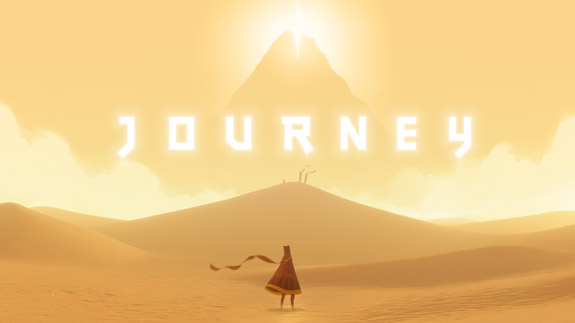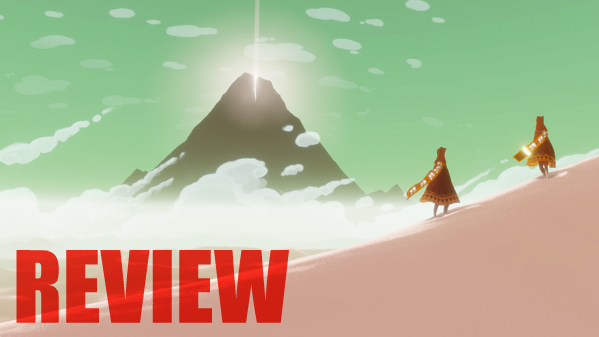Videogames at their worst are trivial and unfulfilling distractions, used purely for entertainment, and tossed aside seconds after completion, never to be looked at again. However, at their very best, videogames can be genuinely inspiring works of art, things that elicit discussion and awe whenever mentioned while still remaining fun to play. These are games after all. And while a lot of talk has floated around lately about how much of a “game” Journey really is, there is no doubt in my mind that Journey represents the very best that videogames have to offer, simultaneously innovating and inspiring during the memorable, albeit short, trip through its excellently-crafted world.
It’s not an exaggeration when I say that Journey is unlike any other game I’ve ever played. Everything in the game feels deliberate. The developers at thatgamecompany have really crafted one of the tightest game experiences ever, where no second feels wasted or unnecessary. Journey doesn’t have any dialogue or any traditional exposition, nor does it have any sort of combat or real conflict. The heart of Journey lies in exploration and movement.
The premise behind Journey is simple: get your character from point A to point B while occasionally solving simple puzzles. Your character can jump, float, and use the wind to glide across the often vast landscapes; though unlike most games that focus on movement, very little skill is necessary to accomplish your goal. Still, thatgamecompany manages to make the movement feel intensely satisfying, and the details in how your character moves or how the wind sometimes blows in the direction you travel to give you a slight boost of speed help players get lost in the beautifully designed world.
If you haven’t been following Journey through its development process and have been reading my review, you would probably assume that the game is solely single player, and you would actually be wrong. Journey is actually a multiplayer game, where another can travel right next to you. The catch is that the game doesn’t have voice chat or even anyway to know the name of the person you’re traveling with. While this means that the traditional negativity of online gaming can’t corrupt your experience; this also means that playing the game cooperatively is purely optional. You don’t need to journey with someone else to finish the game, but it makes the trip slightly easier if you do. This method of online multiplayer actually renewed my faith in humanity, as most of the people that I met through my playthroughs were extremely helpful, guiding me to secret areas or waiting for me to reach certain areas before moving on. It might not be a revolution in online multiplayer, but it was definitely the most unique experience I’ve ever had playing cooperatively with someone online.
In Journey, your experience is wholly unique. You can play in complete isolation or cooperatively, you can explore every nook and cranny or you can let the game guide you, and the people that you meet can show you things you might have never seen before. And speaking of things you’ve never seen, Journey is also aesthetically a very beautiful game. The landscapes are often barren, accented with the ruins of an ancient society. The game looks like a living painting, with every moment inspiring awe. One particular moment where your character slides down glistening sand with a view of the world in the background is undisputedly the most beautiful thing I have seen in a videogame. Games like Uncharted 3 may be graphically impressive because of the detail in the world, but the sheer level of artistic design in Journey is unmatched and a crucial part to what makes the feel so special. The accompanying soundtrack, composed by Austin Wintory, is also a large part of what makes the game as amazing as it is. The soundtrack fits every second and often elicits chills. Everything in Journey comes together to craft an emotional and visceral experience.

The only negative thing I can say about thatgamecompany’s magnum opus is that Journey is incredibly short. At roughly two hours from start to finish, more frugal gamers might be a bit on the fence about diving into Journey and its world. However, as short as it is, the game’s length feels perfect. Particularly during your first play through, the game keeps you constantly engaged. And past the first time the credits roll, players can freely explore each level/area and collect all of the hidden glyphs and symbols hidden throughout.
Journey doesn’t need to be an epic 40-hour experience like Mass Effect or an endless sandbox like Skyrim. It’s an extremely personal two-hour trip through a mysterious world, one you can share with someone whose name you might never know who is playing in a completely different part of the world. At its best, Journey is absolutely the best that videogames have to offer.
—————————————————————————————————————————————
Journey Score:
10/10
Pros:
- An amazingly crafted world full of artistry and imagination
- Simple gameplay masks the depth of exploration
- Unique co-op removes all the traditional negatives of online multiplayer
- Soundtrack and graphics come together to create the total package
Cons:
- Length could be an issue for some
Discuss:
What are your thoughts on Journey? If you’ve played the game, share some memorable experiences you had during your run-through.

